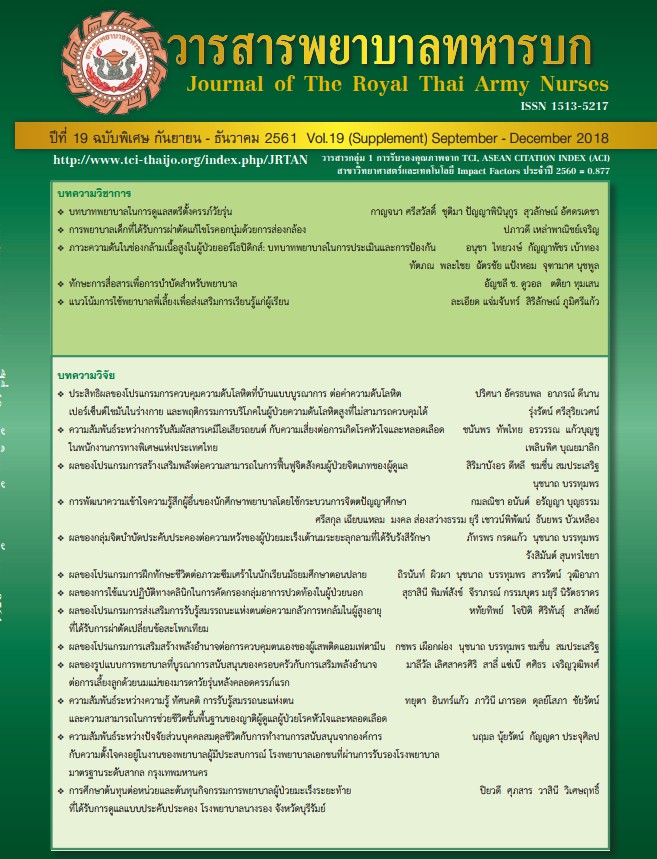Relationships BetweenKnowledge, Attitude, Perceived Self-Efficacy and Capabilities for Basic Life Support among Cardiovascular Disease Caregivers
Keywords:
Knowledge, Attitude, Perceived Self-Efficacy and Capabilities for Basic Life SupportAbstract
This descriptive correlation research aimed to examine the relationships between knowledge, attitude, perceived self-efficacy, and capabilities for basic life support among cardiovascular disease caregivers. A total of 110 cardiovascular disease caregiversat out-patient cardiovascular department were selected using stratified sampling. Data were collected using a questionnaire including the basic life supportknowledge, the attitude towards basic life support, the perceived self-efficacy, and the capabilities to basic life support among cardiovascular disease caregivers. Spearman correlation coefficient was used to analyze the data. The results showed thatthe basic life support knowledge was significantly positively correlated with the attitude towards basic life support, the perceived self-efficacy, and the capabilities to basic life support. In addition, the attitude towards basic life support and the perceived self-efficacy were significantly positively associated with the capabilities to basic life support among cardiovascular disease caregivers. The findings indicated that nurses should provide information and promote positive attitude and self-efficacy towards basic life support among cardiovascular disease caregivers in order to be able to save the life of patients with cardiac arrest in time.
Downloads
References
of non asphyxial out of hospital cardiac arrest. Cochrane DB Syst Rev. 2017;Issue 3.
2. Benjamin EJ, Blaha MJ, Chiuve SE, Cushman M, Das SR, Deo R, Isasi CR. Heart disease and stroke statistics-2017 update: a report from the American Heart Association. Circulation. 2017;135(10):e146-603.
3. Hawkes C, Booth S, Ji C, Brace-McDonnell SJ, Whittington A, Mapstone J., et al. Epidemiology and outcomes from out-of-hospital cardiac arrests in England. Resuscitation. 2017;110:133-40.
4. Mozaffarian D, Benjamin EJ, Go AS, Arnett DK, Blaha MJ, Cushman M, et al. Heart disease and stroke statistics 2016 update: a report from the American Heart Association. Circulation. 2015;133:e1-323.
5. Mani G, Annadurai K, Danasekaran R, Ramasamy JD. A cross-sectional study to assess knowledge and attitudes related to Basic Life Support among undergraduate medical students in Tamil Nadu, India. Progress in Health Sciences. 2014;4(1):47-52.
6. Niklasson C, Bohm K. Attitudes towards bystander cardiopulmonary resuscitation (CPR) among laypersons with and without CPR training. Resuscitation. 2015;96:59.
7. Kumar H, Upadhya S, Ashol S,Chowdari A, Niranjan GM, Dinesh B. A cross-sectional study on awareness and perception about basic life support/cardio-pulmonary resuscitation among undergraduate medical students from coastal South India. Int J MedPublic Health. 2013;3(3):146-50.
8. Roh YS, Issenberg SB. Association of cardiopulmonary resuscitation psychomotor skulls with knowledge and self-efficacy in nursing students. Int J Nurs
Pract. 2014;20(6):674-9.
9. Soowi t B, Thunmmark S, Lhaosupab N, Pitagsavaragon P. An Evaluation of Emergency Medical Service Nursing Course of Kuakarun Faculty of Nursing, Navamindradhiraj University. Journal of The Royal Thai Army Nurses. 2015;16(2):41-9. (in Thai)
10. Thongprasit S. The Effect of informational and emotional support combined with basic cardiac life support training program on psychosocial adjustment in close relatives of coronary syndrome patients at risk of sudden cardiac arrest [dissertation]. Bangkok: Chulalongkorn University; 2006. (in Thai)
11. Bandura A. Self-efficacy: the exercise of control. New York: W. H. Freeman; 1997.
12. Serpytis P, Tamosiunas T, Slusniene A, Glaveckaite S, Kezyte G, Urbanaviciute I, et al. Public knowledge concerning cardiopulmonary resuscitation and automated external defibrillator skills in Lithuania. Sveikatosmokslai/Health Science. 2016;26(4):35-40.
13. Kuramoto N, Morimoto T, Kubota Y, Maeda Y, Seki S, Takada K, et al. Public perception of and willingness to perform bystander CPR in Japan. Resuscitation. 2008;79(3):475-81.
14. Wei YL, Chen LL, Li TC, Ma WF, Peng NH, Huang LC. Self-efficacy of first aid for home accidents among parents with 0-to 4-year-old children
at a metropolitan community health center in Taiwan. Accident Anal Prev. 2013;52:182-7.
15. Vaillancourt C, Stiell IG, Wells GA. Understanding and improving low bystander CPR rates: a systematic review of the literature. CJEM. 2008;10(1):51-65.
16. Lee Y. The effects of CPR education on CPR knowledge and self-efficacy for dental hygiene students from different regions. J Korean Society Dental Hygiene. 2017; 17(6):1003-12.
17. Min PJ, Sangeun J. The effects of knowledge, attitude, and self-efficacy of CPR on willingness to perform CPR in family members of patient with heart disease. Korean J Adult Nurs. 2018; 30(1):79-88.
Downloads
Published
How to Cite
Issue
Section
License
บทความหรือข้อคิดเห็นใดใดที่ปรากฏในวารสารพยาบาลทหารบกเป็นวรรณกรรมของผู้เขียน ซึ่งบรรณาธิการหรือสมาคมพยาบาลทหารบก ไม่จำเป็นต้องเห็นด้วย
บทความที่ได้รับการตีพิมพ์เป็นลิขสิทธิ์ของวารสารพยาบาลทหารบก
The ideas and opinions expressed in the Journal of The Royal Thai Army Nurses are those of the authors and not necessarily those
of the editor or Royal Thai Army Nurses Association.






